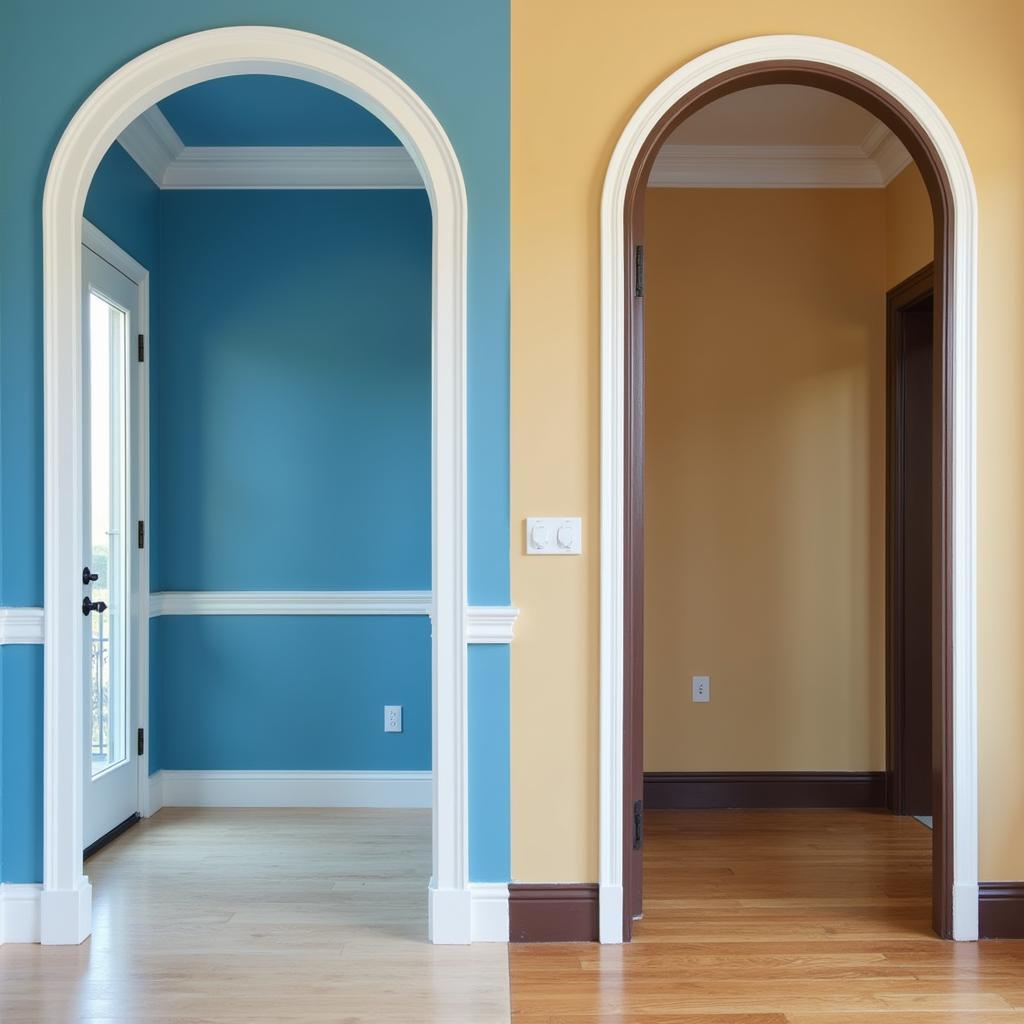Transitioning trim color between rooms can be a subtle art that significantly impacts the overall flow and feel of your home. Choosing the right approach depends on your home’s architecture, your personal style, and the desired mood you want to create. Let’s explore various techniques and considerations to help you achieve seamless and stylish trim transitions. You’ll be painting like a pro in no time! Looking for the perfect paint color? Check out our guide on what color is champagne color.
Understanding the Role of Trim
Trim, including baseboards, door frames, and crown molding, acts as a visual frame for your walls and architectural details. It can unify disparate spaces, create a sense of continuity, or provide striking contrast. Understanding its role is crucial before deciding how to transition colors.
Matching Trim Throughout
The simplest approach is using the same trim color throughout your house. This creates a cohesive look and is especially effective in open-plan homes or houses with a consistent architectural style. White is a classic choice, offering a clean, timeless appeal and making walls appear brighter. However, other neutrals like cream, gray, or even black can create a dramatic and sophisticated effect. This method simplifies the painting process and ensures a harmonious flow between rooms. For more inspiration, explore different interior door color options in our guide, what color to paint interior doors.
Transitioning with Architectural Features
Leveraging existing architectural features like doorways, arches, or columns can create natural breaking points for trim color transitions. Use the architectural element as the dividing line, changing the trim color on either side. This method integrates the transition seamlessly, preventing it from appearing abrupt.
Using a Shared Wall Color
If two adjoining rooms share a wall color, you can use different trim colors in each room without creating a jarring contrast. The consistent wall color acts as a unifying element, allowing the trim to define each space individually while maintaining a sense of connection.
Creating a Gradual Transition
For a more subtle transition, consider using varying shades of the same color. Start with a lighter shade in one room and gradually darken the trim color as you move into the next. This creates a soft, ombre effect that blends the spaces beautifully.
 Transitioning Trim Color with Ombre Effect
Transitioning Trim Color with Ombre Effect
Contrasting Trim Colors
If you’re aiming for a bolder look, contrasting trim colors can create a dynamic and visually interesting transition. Consider using complementary or analogous colors on the color wheel for a harmonious contrast. This approach works particularly well in homes with distinct room styles or when highlighting specific architectural elements. Think about how many paint colors you’re using overall. Our guide on how many paint colors in a house can help you strike the right balance.
Choosing the Right Paint Finish
The paint finish for your trim plays a significant role in how the transition appears. A semi-gloss or gloss finish is typically recommended for trim as it highlights details and is easier to clean. However, if you prefer a less reflective look, a satin finish can be a good alternative. Maintain consistency in the finish across all trim, regardless of color, to ensure a cohesive look. Unsure about baseboard colors? Explore some options at what color should baseboards be.
 Contrasting Trim Colors in Adjoining Rooms
Contrasting Trim Colors in Adjoining Rooms
Tips for Success
- Test your colors: Before committing, test your chosen trim colors in each room to see how they look in different lighting conditions.
- Consider the surrounding decor: Ensure your trim colors complement the existing furniture and decor in each room.
- Prepare your surfaces: Properly prepping your trim before painting is crucial for a smooth and professional finish.
Conclusion
Transitioning trim color between rooms can enhance your home’s aesthetics and create a sense of flow and personality. Whether you opt for a seamless blend or a bold contrast, the key is to consider your home’s architecture, your personal style, and the overall mood you want to create. By carefully planning and executing your trim transitions, you can transform your home into a cohesive and stylish sanctuary. Need some color inspiration? Learn more about a popular neutral in our guide on what color is agreeable gray.
FAQ
- Can I use different trim colors in every room?
- What is the best way to transition trim color in an open-concept home?
- Should trim color match the wall color or contrast with it?
- How do I choose the right trim color for my home’s style?
- What is the most popular trim color?
- Can I paint my trim a different color than my doors?
- How do I prevent bleed-through when painting trim a different color?
Common Scenarios
- Scenario 1: Open concept living room and kitchen – Consider using the same trim color for a unified look.
- Scenario 2: Transitioning from a hallway to a bedroom – Use the doorway as a natural breaking point for the color change.
- Scenario 3: Two adjacent rooms with different wall colors – A shared neutral trim color can create a cohesive feel.
Further Reading
Explore related articles on our website, including those about choosing baseboard colors and the number of paint colors in a house.
Need Help?
For personalized guidance on transitioning trim colors in your home, contact us at 0373298888, email us at [email protected], or visit our showroom at 86 Cầu Giấy, Hanoi. Our team of color experts is available 24/7 to assist you.
